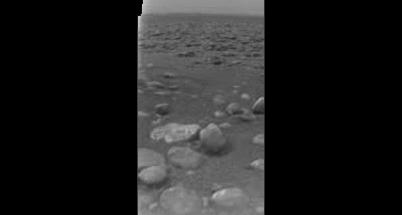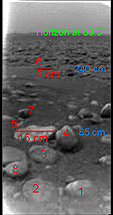


This is the first coloured view of Titan's surface, following processing to add reflection spectra data, gives a better indication of the actual colour of the surface. Initially thought to be rocks or ice blocks, they are more pebble-sized. The two rock-like objects just below the middle of the image are about 15 centimetres (left) and 4 centimetres (centre) across respectively, at a distance of about 85 centimetres from Huygens. The surface is darker than originally expected, consisting of a mixture of water and hydrocarbon ice. There is also evidence of erosion at the base of these objects, indicating possible fluvial activity.
It appears that Huygens may have landed in a dry riverbed. However, the liquid that flowed here was not water but methane. Spectra measurements (colour) are consistent with a composition of dirty water ice rather than silicate rocks. However, these are rock-like solid at Titan's temperatures.
Titan's soil appears to consist at least in part of precipitated deposits of the
organic haze that shrouds the planet. This dark material settles out of the
atmosphere. When washed off high elevations by methane rain, it concentrates at
the bottom of the drainage channels and riverbeds contributing to the dark areas
seen in DISR images.
This raw image was returned by the ESA Huygens DISR camera after the probe descended through the atmosphere of Titan. It shows the surface of Titan with ice blocks strewn around. The size and distance of the blocks will be determined when the image is properly processed.
This mosaic of three frames provides unprecedented detail of the high ridge area including the flow down into a major river channel from different sources.
Images captured by the DISR reveal that Titan has extraordinarily Earth-like meteorology and geology. Images show a complex network of narrow drainage channels running from brighter highlands to lower, flatter, dark regions. These channels merge into river systems running into lakebeds featuring offshore "islands" and "shoals" remarkably similar to those on Earth.
Other Huygens' data
provide strong evidence for liquids flowing on Titan. However, the fluid
involved is methane, a simple organic compound that can exist as a liquid or gas
at Titan's sub-170 degree C temperatures, rather than water as on Earth.
Titan's rivers and lakes appear dry at the moment, but rain may have occurred
not long ago.
A single image from the Huygens DISR instrument of a dark plain area on Titan, seen during
descent to the landing site, that indicates flow around bright 'islands'. The areas below
and above the bright islands may be at different elevations.
A single Huygens DISR image that shows two new features on the surface of Titan. A bright
linear feature suggests an area where water ice may have been extruded onto the surface.
Also visible are short, stubby dark channels that may have been formed by 'springs' of
liquid methane rather than methane 'rain'.
A view of Titan from the VIMS instrument on the Cassini orbiter. The Huygens probe landed
in the small red circle on the boundary of the bright and dark regions. The size of the
circle shows the field of view of the Huygens DISR imager from an altitude of 20 kilometres.
This picture is a composite of 30 images from ESA's Huygens probe. They were taken from an
altitude varying from 13 kilometres down to 8 kilometres when the probe was descending towards
its landing site. These images were taken with a resolution of about 20 metres per pixel and
cover an area extending out to 30 kilometres.
This image, taken during the Huygens descent to the surface of Titan, shows the boundary
between the lighter-coloured uplifted terrain, marked with what appear to be drainage
channels, and darker lower areas. These images were taken from an altitude of about 8
kilometres with a resolution of about 20 metres per pixel.
Composite of Titan's surface seen during descent. It shows a full 360-degree view around
Huygens. The left-hand side, behind Huygens, shows a boundary between light and dark areas.
The white streaks seen near this boundary could be ground 'fog' of methane or ethane vapour,
as they were not immediately visible from higher altitudes. As the probe descended, it
drifted over a plateau (centre of image) and was heading towards its landing site in a dark
area (right). This dark area is possibly a drainage channel which might still contain liquid
material. From the drift of the probe, the wind speed has been estimated at around 6-7
metres per second. These images were taken from an altitude of about 8 kilometres with a
resolution of about 20 metres per pixel.
This is one of the first raw images returned by the ESA Huygens probe during its successful
descent. It was taken from an altitude of 16.2 kilometres with a resolution of approximately
40 metres per pixel. It apparently shows short, stubby drainage channels leading to a shoreline.
This is one of the first raw images returned by the ESA Huygens probe during its successful
descent.It was taken at an altitude of 8 kilometres with a resolution of 20 metres per pixel.
It shows what could be the landing site, with shorelines and boundaries between raised ground
and flooded plains.
 Sounds of Titan during Huygens Descent
Sounds of Titan during Huygens Descent
This recording is a laboratory reconstruction of the sounds heard by Huygens' microphones.
Several sound samples, taken at different times during the descent, are here combined
together and give a realistic reproduction of what a traveller on board Huygens would have
heard during one minute of the descent through Titan's atmosphere.
(All images copyright ESA/NASA/JPL/University of Arizona)
 Preliminary Scientific Results from Huygens
- ESA Press Release (21 January 2005)
Preliminary Scientific Results from Huygens
- ESA Press Release (21 January 2005) Huygens Press Conference on January 21
- ESA Press Release (18 January 2005)
Huygens Press Conference on January 21
- ESA Press Release (18 January 2005) Huygens Lands on Titan
- ESA Press Release (14 January 2005)
Huygens Lands on Titan
- ESA Press Release (14 January 2005)
 Huygens home page at NSSDCA
Huygens home page at NSSDCA
 Cassini home page at NSSDCA
Cassini home page at NSSDCA
 Huygens home page at ESA
Huygens home page at ESA
 Planetary Home Page
Planetary Home Page
 Author/Curator:
Author/Curator: